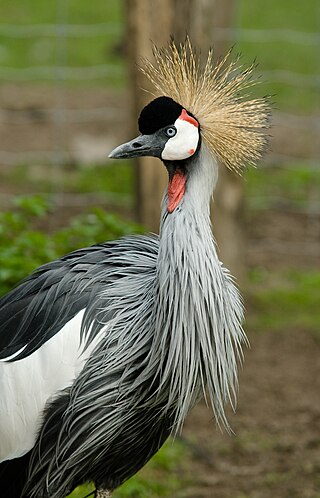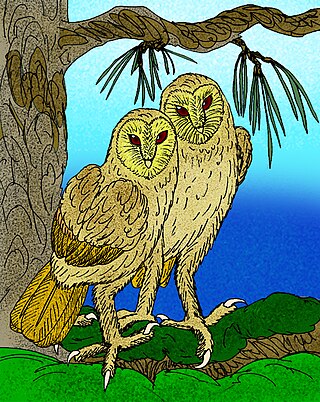
The ibis are a group of long-legged wading birds in the family Threskiornithidae that inhabit wetlands, forests and plains. "Ibis" derives from the Latin and Ancient Greek word for this group of birds. It also occurs in the scientific name of the western cattle egret mistakenly identified in 1757 as being the sacred ibis.

The Gruiformes are an order containing a considerable number of living and extinct bird families, with a widespread geographical diversity. Gruiform means "crane-like".

Flightless birds are birds that cannot fly. They have, through evolution, lost the ability to fly. There are over 60 extant species, including the well-known ratites and penguins. The smallest flightless bird is the Inaccessible Island rail. The largest flightless bird, which is also the largest living bird in general, is the common ostrich.

The St. Croix macaw or Puerto Rican macaw is an extinct species of macaw whose remains have been found on the Caribbean islands of St. Croix and Puerto Rico. It was described in 1937 based on a tibiotarsus leg bone unearthed from a kitchen midden at a pre-Columbian site on St. Croix. A second specimen consisting of various bones from a similar site on Puerto Rico was described in 2008, while a coracoid from Montserrat may belong to this or another extinct species of macaw. The St. Croix macaw is one of 13 extinct macaw species that have been proposed to have lived on the Caribbean islands. Macaws were frequently transported long distances by humans in prehistoric and historical times, so it is impossible to know whether species known only from bones or accounts were native or imported.

Tyto pollens is an extinct giant barn owl which lived in the Bahamas during the last Ice Age.

Cygnus falconeri is an extinct, very large swan known from Middle Pleistocene-aged deposits from Malta and Sicily. Its dimensions are described as exceeding those of the living mute swan by one-third, which would give a bill-to-tail length of about 190–210 cm (75–83 in). By comparison to the bones of living swans, it can be estimated that it weighed around 16 kg (35 lb) and had a wingspan of about 3 m (9.8 ft). Due to its size, it may have been flightless. The remains of the species are associated with the Elephas mnaidriensis faunal complex, and became extinct long before the arrival of people to Sicily and Malta. Its bones are exhibited at Għar Dalam museum in Birżebbuġa, Malta.
Speleoperipatus is a monospecific genus of velvet worm in the Peripatidae family, containing the single species Speleoperipatus spelaeus. This species is a pale greenish yellow, almost white, with 22 or 23 pairs of legs and no eyes. Specimens range from 27 mm to 34 mm in length. The minimum number of leg pairs found in this species (22) is also the minimum number found in the neotropical Peripatidae. This velvet worm is viviparous, with mothers supplying nourishment to their embryos through a placenta.
Jackson's Bay Cave is a very large cave on the Portland Ridge in Clarendon near the south coast of Jamaica. It is considered to be one of the most beautiful in the Caribbean. It was discovered in 1964. It is part of the Jackson bay cave system, consisting of 14 unconnected caves, and over 9200m of cumulated caves passages mapped since then. The longest of them, Jackson Bay Great Cave is over 3.360 kilometres (2.088 mi) long.
Paleontology or palaeontology is the study of prehistoric life forms on Earth through the examination of plant and animal fossils. This includes the study of body fossils, tracks (ichnites), burrows, cast-off parts, fossilised feces (coprolites), palynomorphs and chemical residues. Because humans have encountered fossils for millennia, paleontology has a long history both before and after becoming formalized as a science. This article records significant discoveries and events related to paleontology that occurred or were published in the year 1977.
Paleontology or palaeontology is the study of prehistoric life forms on Earth through the examination of plant and animal fossils. This includes the study of body fossils, tracks (ichnites), burrows, cast-off parts, fossilised feces (coprolites), palynomorphs and chemical residues. Because humans have encountered fossils for millennia, paleontology has a long history both before and after becoming formalized as a science. This article records significant discoveries and events related to paleontology that occurred or were published in the year 1976.
The Jamaican caracara is a prehistoric species of terrestrial bird in the falcon family, Falconidae. It was native to the island of Jamaica in the Caribbean, where it probably inhabited dry forests in the island's south during the early Holocene. This species was described based on fossils discovered in the Skeleton Cave in the Jackson's Bay Cave system on the south coast of Portland Ridge.

The Jamaican ibis, Jamaican flightless ibis or clubbed-wing ibis is an extinct bird species of the ibis subfamily uniquely characterized by its club-like wings. It is the only species in the genus Xenicibis, and one of only two flightless ibis genera, the other being the genus Apteribis which was endemic to Hawaii's islands of Maui Nui.
Long Mile Cave, sometimes known locally as Pick'ny Mama Cave or Hell's Gate Cave, is a palaeontological and palaeoanthropological site in the Cockpit Country of north-western Jamaica.
Red Hills Fissure is a palaeontological site at the Red Hills in Saint Andrew Parish of south-eastern Jamaica.
The Niue rail is an extinct species of flightless bird in the Rallidae, or rail family.
The Pindai Caves of New Caledonia are an archaeological and palaeontological site important for the study of prehistoric human settlement as well as of the Holocene fauna of the island. The Pindai area has been occupied by humans for varying periods over the last 2,800 years.

The small-billed moa-nalo, also known as the stumbling moa-nalo, is a species of moa-nalo, one of a group of extinct, flightless, large goose-like ducks, which evolved in the Hawaiian Islands of the North Pacific Ocean. It was described in 1991 from subfossil material collected in September 1982 by Storrs Olson, Helen James and others, from the Auwahi Cave on the southern slopes of Haleakalā, on the island of Maui.








